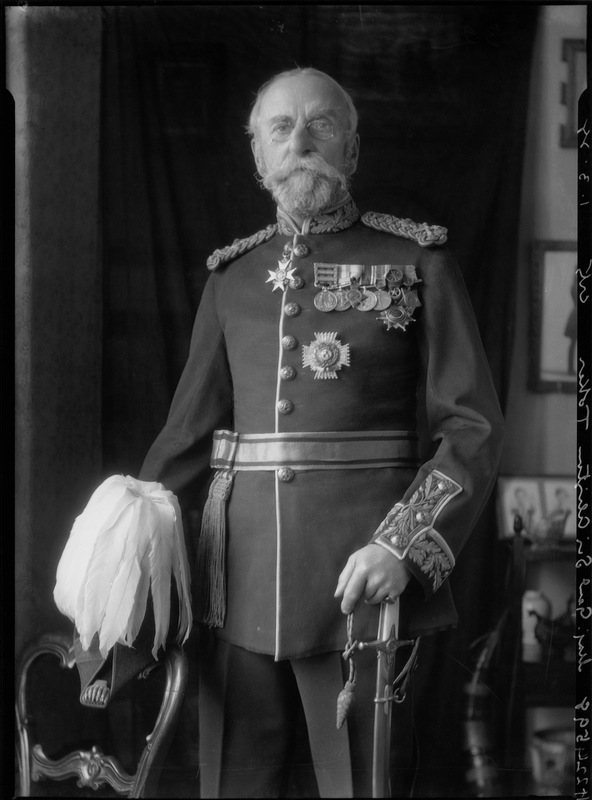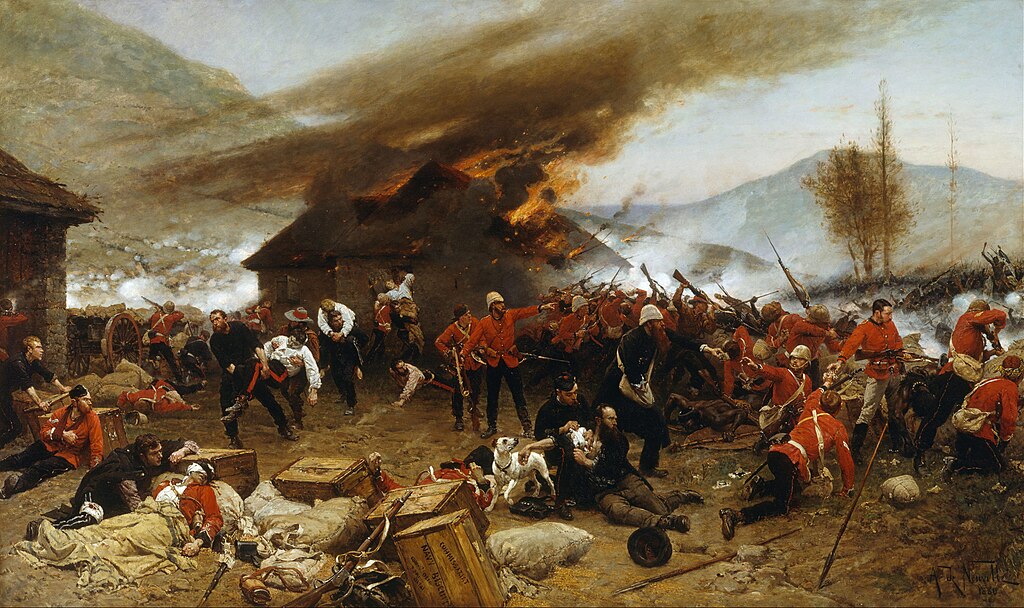Several of my relatives kept journals and published their memoirs, among them Frederick Jemmet Mainwaring (1796–1858), my second cousin six times removed, who wrote an account of his experiences in the Peninsular War. I suppose Mainwaring and the others could reasonably be described, as ‘witnesses to history’, though in a sense we all are. History, however grand it sometimes seems, is where we live.
On 5 April 1810, Frederick, aged 13, joined the 45th Regiment of Foot as an ensign without purchase. Later that year, still an ensign, he transferred to the 51st Regiment of Foot, where his uncle John Montague Mainwaring (1761–1842) was Lieutenant-Colonel. Frederick was promoted to Lieutenant in 1813 and Captain in 1828. He became a Major by purchase in 1838 and finally a Lieutenant Colonel without purchase, unattached, in 1849.
During the Napoleonic wars Frederick Mainwaring served in the Iberian Peninsula for three years, at Fuentes d’Oñoro, the siege of Badajoz, Salamanca, the siege of Burgos, San Marcial, Vitoria, the Pyrenees, and the Nivelle. He returned to Britain in early 1814, one of an escort guarding French prisoners of war.
Napoleon escaped from Elba in February 1815. The 51st, with Lieutenant Frederick Mainwaring, embarked for Ostend the following month, and were at the Battle of Waterloo in June. Among its achievements the regiment prevented 100 French cuirassiers from escaping.
Frederick took part in all these many battles without ever suffering a wound.
In 1844 he published his memoirs of service, anonymously, in the ‘United Service Journal and Naval and Military Magazine’ as ‘Four years of a soldier’s life, by a field officer’. It was published in several parts. The Battle of Waterloo is described in the issue of November 1844.
For some hours we remained perfectly still, drying our arms and clothes, as best we might, until about half-past ten, when we received an order to advance, and move down to the right of the position, halting about four hundred yards in rear of Hougomont; here the rising-ground to our left and front prevented us from seeing the enemy; and in columns of regiments, the brigade remained for about a quarter of an hour in silent and eager anxiety, waiting the commencement of the action. At length "pealed the thunder" of a single cannon, as a battery of artillery close to us opened its fire on the advancing columns of the French. "There goes the first gun of the greatest action that has been fought in Europe for the last fifty years," burst from the lips of a young officer; and hardly were the words out of his lips, when an Aide-de-Camp galloping up, ordered out some light troops to fire at the flanks of the French coming round the wood of Hougomont; three companies were dashed forward in a moment, and the one I then belonged to, headed by my gallant old Captain (one of the bravest soldiers I ever knew), was the leading one of the skirmishers. Owing to the undulating nature of the ground, and the high standing corn, we did not come in contact with the enemy's light troops covering the advance of their columns until within about forty paces; then, opening our fire, and loudly cheering, we charged forwards, making them retire before us, though they were supported by cavalry. We were now on a plain, but continued advancing, driving them on beyond the enclosures of Hougomont, close back upon their columns; this bold and somewhat rash conduct of my Captain, I doubt not, we should have speedily had cause to rue, had not our advance been checked by an order to retire, which, as it was not brought by a Staff Officer, he refused to obey, although he halted; however, an Aide-de-Camp galloping up with an order to that effect from Lord Hill, we then slowly retraced our steps about a hundred yards, and met the remainder of the regiment coming up in extended order. At this time, the battle had scarcely commenced, we being the first infantry that had as yet fired a shot, and in this short advance of about ten minutes or a quarter of an hour, our loss had already been twelve killed and wounded out of a company of seventy men. In this position we remained the whole day, close to Hougomont, alternately advancing and retiring with the ebb and flow of the tide of battle.
Of the operations of our companions in arms to our left, who suffered so severely, and fought so gallantly, it is not for me to speak, their deeds have been too often told by abler and better pens than mine; I can only tell of what passed immediately around me; " 'mid the smoke, and shout, and din of battle," we had enough to do, however unimportant one's own individual part, to note that of others; suffice it to say, in the words of a friend, "the din in mine ear, for about nine hours, was more like the roll of a hundred thousand drums, of all sizes and shapes, than anything I can compare it to."
A little before sunset, when all was lost to the enemy, I well remember the last gallant but useless attempt of the Old Imperial Guard. The firing had ceased in our immediate front; in all parts the splendid and brave cavalry of the foe had been almost annihilated, broken like "frail barques on a rocky strand," against the solid squares of the British infantry - they had gone down horse and man, and perished nobly for their chief; their infantry had been beaten, driven back, and everywhere repulsed. When one more gallant effort was now to be made, I saw the dark column in one solid enormous mass crown the plateau and move forward; but here they halt, they waver, long lanes of light are seen through the black body, and borne down by the storm of grape and cannon-shot hailed upon them from our artillery, they give way, and the instant and simultaneous advance of the whole British line, 'mid loud huzzas of victory, told that, with that sun which was now going down in almost tropical beauty, the star of Napoleon and the invincibility of this gallant band were setting for ever.
Parties of Prussian cavalry began now to push past us, whilst the British, tired and jaded with a long day of fatigue and fighting, were ordered to halt, and moving into the orchard of Hougomont, we piled our arms close to the chateau, a heap of blackened ruins; we were soon asleep, whilst thousands who had fought their last, and slept "the sleep which knows no waking," save that of the last awful day, were pillowed on the earth everywhere around us. At day-break, I walked over the battle-field, and though pretty well hardened by practice for such sights, yet this was, in truth, a dreadful one; the dead in many places were literally piled in heaps; the wounded, few of whom had yet been removed, were some silently and patiently suffering, others writhing and screaming with agony, some loudly calling for water, and praying for death to end their misery. Everything that human means could do was being done, and fond as $I$ then was of the excitement of campaigning, this was a scene of human misery too painful to dwell upon, and upon which the eye could not but rest with horror. Here, stark and cold in death, victims to the ambition of one man, lay thousands of brave and gallant human beings, who but yesterday trod and stepped on this pleasant earth full of life and hope, and now we moved over their bodies as over senseless clods. Close to Hougomont lay the corpse of an officer of our Guards, and across his breast the dead body of a French Grenadier; the officer had been shot through the head, a loaf of brown bread half out of the Frenchman's havresack was spattered with his brains; I had not tasted food since daylight of yesterday's morn, and ravenous with hunger, I scraped off the brains, and feasted on the bread; at any other time I should have turned from it with disgust. But years have past-Waterloo and its glories are remembered but as history; the British soldier looks forward with hope for future wars and other fields in which harvests of glory are now perhaps ripening for him. We have, no doubt, many a Wellington yet unborn, but a Napoleon comes not in the lapse of many centuries, and long will it be ere two such armies clash again. The Peninsula Legions of Wellington, the British Cæsar, the Old Imperial Guard of Napoleon, honour, chivalry, bravery, and fidelity, all combined, better or braver troops never went down upon a battle-field than those that perished there!
About nine o'clock in the morning, we received orders to march, and leaving the field of battle, moved in the direction of Nivelles, where we halted and encamped that night. When about two miles upon the road, I remember turning to look back at the ground upon which the action had been fought; at that distance, it appeared exactly as I have seen a ploughed field in winter, covered with crows, so numerous were the dead bodies upon it. In silence I breathed a prayer to the God of battles, who had preserved me through its dangers; and blessed be His holy name who shielded me then and since, 'mid all the perils and vicissitudes of a soldier's care-worn life, whether my path was on the stormy deep, or through the leaden shower of battle, or in climes where many a gallant comrade, the survivor of a hundred fights, has fallen victim to the pestilential blast of fever, whilst we who have stood around his grave, to pay the last sad tribute to the departed brave, have expected that perhaps the next sunset might see our companions there to perform the same friendly office for one of us.
The Battle of Waterloo was fought on 18 June 1815 between Napoleon’s French Army and a coalition of English and Prussian troops led by the Duke of Wellington and Marshal Blücher. Waterloo concluded a war that had raged for 23 years, ending French attempts to dominate Europe.
The French army, of 69,000 men, faced Wellington’s 67,000 men and 48,000 Prussians. Nearly 50,000 men were killed or wounded: 25,000 French, 15,000 from Wellington’s army, and 6,600 Prussians. [Waterloo was a minor skirmish by later standards. The battle of the Somme, between July and mid-November 1916, produced more than a million casualties, with 300,000 dead. The British lost 20,000 killed on the first morning.]
Although written many years after the events described, Mainwaring’s memoir is a convincing portrait of a young lieutenant’s experience of the battle. Large-scale history of course passes over the deafening noise of the battle, the excitement and fear of the soldiers, and the sickening sight of the dead and wounded afterwards. Memoirs like Frederick Mainwaring’s bring us closer to the detail of ‘great moments of history’ ; close-up Waterloo was appalling. As Wilfred Owen wrote, no one, however ardent for some desperate glory, should dare ‘to tell the old Lie: Dulce et decorum est Pro patria mori‘.

Scene from the panorama of the Battle of Waterloo showing the Duke of Wellington and his staff (top right) sheltering from French cuirassiers in a square of Highland infantry.
Photograph by Denis Jervis retrieved from Wikimedia Commons (cc-by-sa-2.00).
Related posts and further reading
Frederick Jemmet Mainwaring’s memoirs has been published with annotations as Four years at War: The Memoirs of Lt. Frederick Mainwaring 51st Foot in the Peninsula and at Waterloo 1811-15 edited by Gareth Glover.
Wikitree: Frederick Jemmett Mainwaring (1796 – 1858)
This post was created as part of Amy Johnson Crow’s 52 Ancestors in 52 Weeks challenge. This week’s theme is “Witness to History.”








































